We’re happy to feature Dr. Anthony Malone’s daily log of koi adventures during his 2018 Niigata trip. It has lots of humor and shows the fun and wonder when hunting for koi in Japan. We hope it entices you to join Taro for his next Niigata Harvest trip and tour. Enjoy! After reading you can search our site for the best Koi for sale.
Japan Koi Hunt, 2018 by Anthony Malone
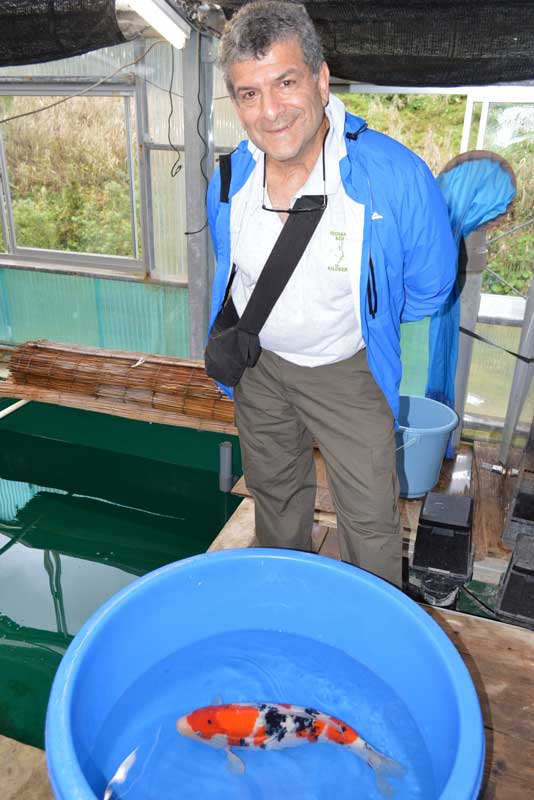
Dr. Anthony Malone
October 9, 2018
I’m up at 4 a.m. Couldn’t sleep anyway and never can the night before I leave on my now, what has become “annual,” Japan Koi Hunting Trip. This will be my 7th time in Japan; and each time I go, it gets better, more interesting, and more exciting.
October 10, 2018
After several weather-related delays, I finally make it to Honolulu where I will meet up with Taro Kodama, our koi dealer, guide, and translator; and Joan Fujimoto, another long time koi nut and customer of Taro’s. Together we’ll fly to Tokyo and meet up with several more koi-crazy people to begin the annual search for the perfect “Living Jewels” that we know are there waiting for us.
October 11, 2018
The 3 of us leave Honolulu the morning of October 10th, and after a 7-hour flight, get to Tokyo the next day, the 11th, in the afternoon. This losing an entire day never ceases to confuse me—suffice to know we’ll make it up on the return trip, sometimes getting home before we leave….what?! It takes about 2 hours via Shinkansen, the famous bullet train that goes over 150 mph it is said, to get to Nagaoka Station where Taro has arranged hotel rooms for everyone just for tonight.
Tomorrow night and the rest of the week we’ll spend at our favorite koi hotel in Ojiya, the New Plaza, where rooms run about $54 /night and the guys behind the hotel front desk immediately memorize every guest’s face and room number and automatically hand you the correct key for your room every time without your even asking! You can get breakfast here, too, for a minimal fee—breakfast is weird by Western standards, but substantial and good.
October 12, 2018
Taro has arranged for us to observe “Ikeage” which is the harvesting of all the koi that have spent the entire summer in one of the mud ponds way up in the mountains of the Niigata koi breeders.
The weather is crisp, and the Japanese autumn foliage and the surrounding mountains are simply splendid—if heaven doesn’t include scenes like this, I’ll truly be disappointed.
“Since 1918” says the sign on the building. Torazo was one of the first breeders to breed Taisho Sanke, but as of late, breeds mostly Kohaku.
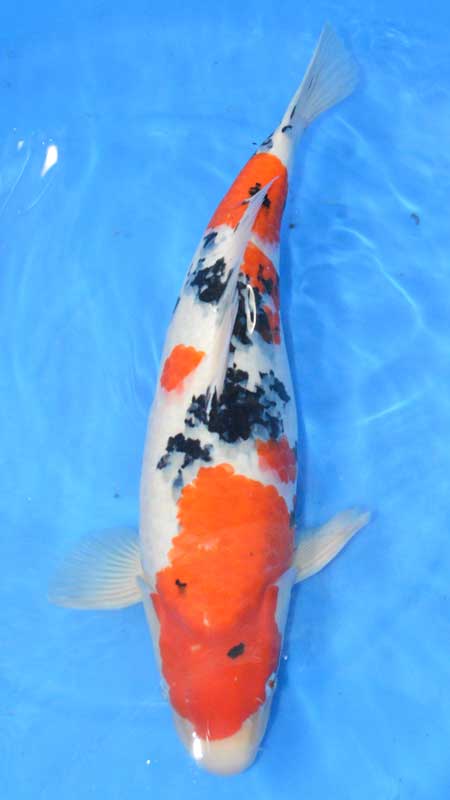
“That’s it,” I tell myself. “No more buying koi for at least several days for me. I gotta go easy and have solid will power. It’s a long trip after all. And besides my wife will kill me—somehow she just knows whenever I even think about buying a koi!”
Our next stop is Otsuka (pronounced Oat-ska, not OT-SU-KA, please!) Here we see all varieties of koi including his famous Ki Utsuri and Kage Utsuri. Here I find and buy a great nisai Asagi—but it’s not for me. It’s for a friend, so my willpower is still strong (patting myself on the back).
Oh and by the way, going from breeder to breeder and overbuying great koi is not all we do on this trip. No siree, Bob. We also eat a lot, at the very places in Niigata where the people who live here eat.
You see that is another advantage of having a dealer/guide who has lived in Japan and has been coming to this area for many years. He knows all the authentic restaurants and bars where the food is traditional and always outstanding.
We go to sushi places, okonomiyaki specialists, ramen joints, and a host of other great places to eat. And several times we went with the breeders themselves and talked koi until the wee hours. Boy, the sake flowed; and the food just kept on coming!
October 13, 2018
A relatively new breeder is next called Maruhide. This breeder used to be Isa’s right-hand man and now has his own farm specializing in Doitsu koi, and they are phenomenal and very fairly priced.
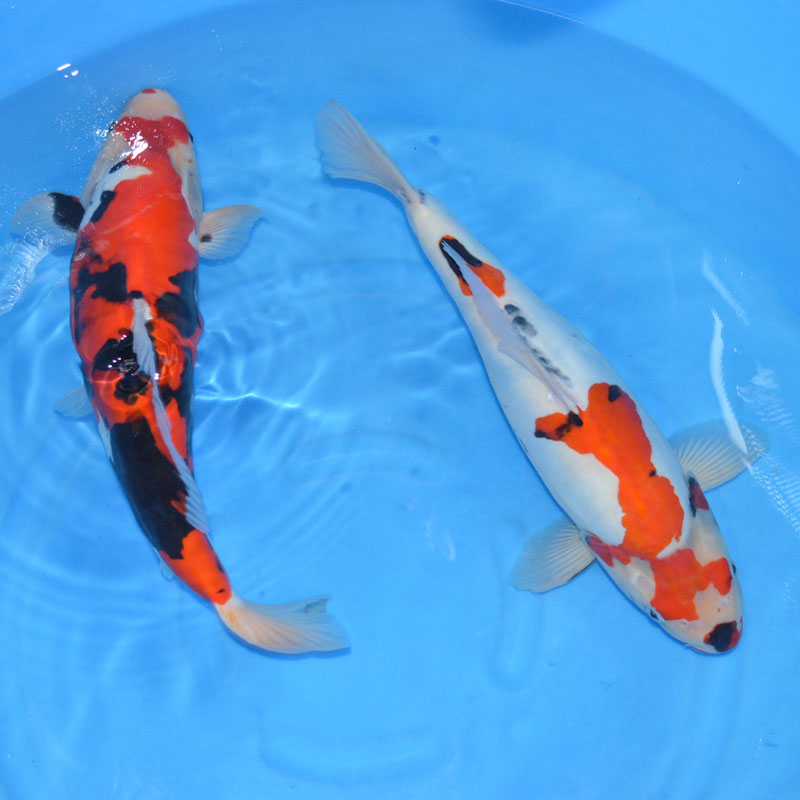
Next stop is Kanno Koi Farm, breeder of what many believe are the finest Goshiki in the world (pronounced goe-shki, NOT GO SHEE KI, please!). I figure I’m safe here, won’t buy anything, because I am not a big Goshiki fan.
Yeah, right. I end up buying a beautiful sansai with deep flawless beni and a dark deep background probably nice enough to go to the All Japan Show. Taro talks the breeder into throwing in a very nice 2-yr old for no additional charge! (THAT’s the advantage of having a dealer and guide who knows the breeders)
It is at this point that I am feeling particularly guilty about buying four koi so early in the trip—the first buying day!—and begin to worry what my wife will say when she finds out—and she always finds out.
I believe it is Joan who then advises me to shake off the bonds of moderation and just buy what my koi judgement tells me to; in other words to become “liberated”, I think she called it. I make a very important decision to do just that, and almost immediately I feel as free as a soaring tancho crane (the national bird of Japan).
Kawakami Koi Farm is our next breeder; and he has just harvested some really pretty and unique Beni Kikokuryu, Shusui and Kujaku, all non-Gosanke so again, despite being liberated, I feel fairly safe… until I buy 3 Beni Kikokuryu, one of which has a pattern on its head that looks like the “Fight Breast Cancer” crossed ribbon.
I read mammograms for a living, so how in the world could a liberated guy like me pass it up, I ask you? Well, I don’t; I buy it and 2 others, one of which is all gold and the other which has a pattern on its head that looks like modern art. My wife will like that when I show it to her, right?
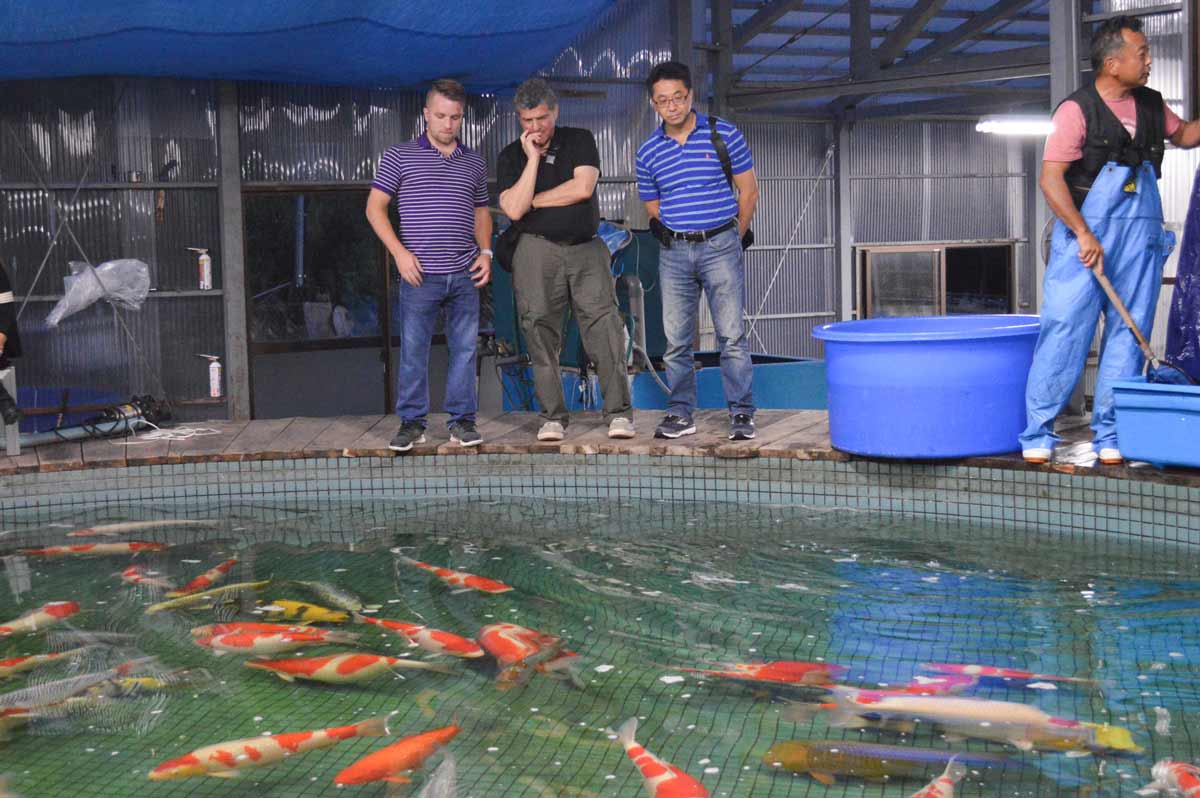
I am not sure how the breeder breeds so many varieties and gets them so large while remaining literally flawless. Their prices of course reflect this! “Holy cow, how much?!” is heard echoing off the walls constantly as customers enter this “Koi Heaven.”
Taro buys a huge and beautiful Ginrin Tancho Kohaku for a customer and believe it or not, had to make the selection from 6 that were in the mosaic pond, one more beautiful than the next.
I decide I really like a Doitsu Mukashi Ogon which is really cool-looking and not too expensive (it was NOT in the mosaic pond, but in another one where less expensive specimens are kept, more my style)
Miyatora is a very good breeder of many varieties and is our next stop. He has great koi at reasonable prices; and since I just bought a Doitsu Mukashi, I look for a regular scaled Mukashi Ogon and guess what? I find a beauty, 2-years old and about 23 inches length. By the way, in this day and age, 23-24 inches and even larger nisai are not uncommon at the breeders in Japan.
October 14, 2018
Today Taro asks me if I have ever been to Mr. Kase’s place. It’s called Koshiji. Even though this is my 7th time here I tell him, “No, I have never been. Is it any good?” He tells me I will have to decide for myself, and we go.
The first thing I notice is that he has many, many varieties including very good Shiro Utsuri. I have been looking for good Shiro Utsuri other than from Omosako. After all, everybody has or wants Shiro Utsuri from Omosako. Simply because of this, I want to see if I can find good Shiro Utsuri from somewhere else and lo and behold here at Koshiji I believe I finally did!
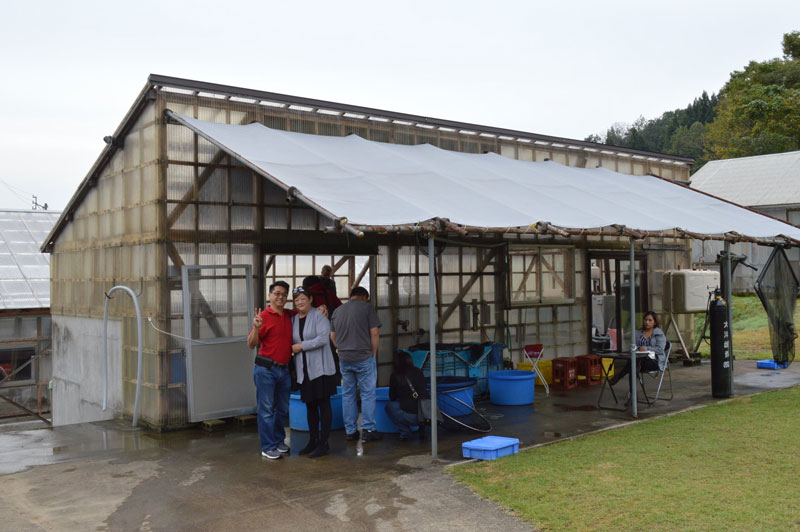
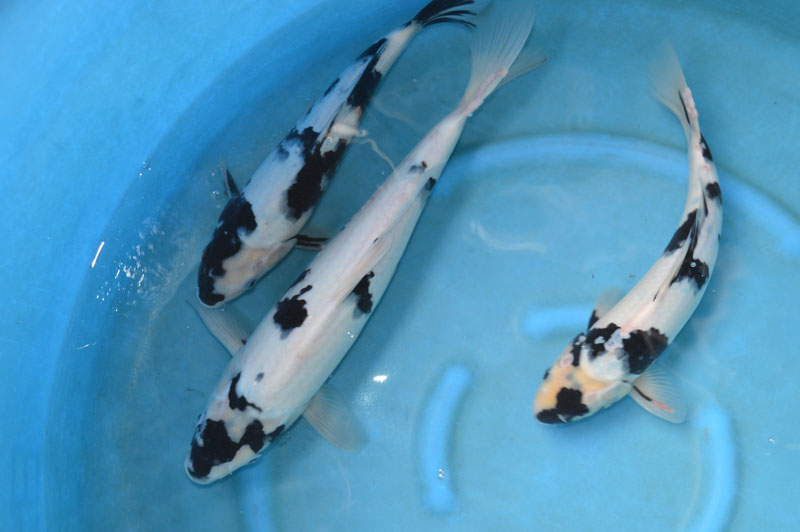
We again stop at Isa, arguably the best Showa breeder in the world. We visit Mr. Isa’s greenhouse where the best 3- and 4-year old koi are currently kept. Mr. Isa bowls an extremely brilliant 3-year old Showa, and we all agree she is fantastic.
I ask Taro to get a price which he does and whispers it in my ear… “Forty-five,” he says.
Wow, I think $4,500. A good piece of change for a 3-year old, but too rich for my blood at this point; and we go to another “less expensive” pond where I find a very nice 3-year old that I tell Mr. Isa I want to see. In the bowl she looks great, and again I ask Taro to get the price.
“Thirteen,” he whispers to me.
$1,300 for this Isa Showa I think, that’s a steal. “I’ll take IT!” I yell to Taro. “How come only $1,300 dollars?”
Taro begins to laugh saying between breaths, “It’s not thirteen hundred, it’s thirteen THOUSAND!”
Aha, no wonder it seemed so cheap. But it still makes no sense to me that this koi is $13,000 and not as nice as the first one which was $4,500; and I ask Taro why this is.
Taro now can hardly breathe; he is laughing so hard. “That first one is not forty-five hundred, it is FORTY-FIVE THOUSAND!!!”
“Oh,” I embarrassingly say. “Can we go to a different and hopefully less expensive greenhouse now?” And we do.
We go to where Mr. Isa keeps 4-year olds and up; and these koi are simply awe inspiring, many looking as if they were crafted from painted porcelain! I fall in love with a 4-year old; and figure since I am so “liberated” now and besides, the world could end tomorrow, I actually buy it. I’m a bit shell-shocked, I paid that much for a koi; but a confident and “liberated” guy like me will get over it shortly—at least by the time we get to the next breeder.
Mr. Isa puts my new purchase in an outdoor pond that contains about 50 or 60 other koi that customers have purchased. I stand over the pond on a narrow walkway figuring the koi swimming underneath me are collectively valued at more than 2 million dollars. As the Wicked Witch of the West said—What a world!
October 15, 2018
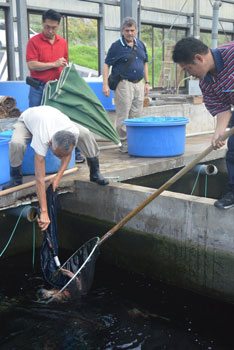 Our first breeder today is Mano Koi Farm which is an old place tucked in behind the Ojiya auction center. Mr. Mano breeds a lot of varieties, but specializes in Shusui.
Our first breeder today is Mano Koi Farm which is an old place tucked in behind the Ojiya auction center. Mr. Mano breeds a lot of varieties, but specializes in Shusui.
As we walk in the greenhouse, we notice the water levels in all the ponds is 3–4 feet are below the ponds’ rims; and we ask him why this is. He says his koi are jumpy for some reason, always have been, and the best way to keep them in their ponds is to lower the water level. He tells us that this doesn’t always prove to be effective as just recently one of his Shusui jumped out of its pond and sailed right through the open window and out into the river below. I guess it got away.
I spot a very unique Shusui with very unique markings on its head and shoulders; and since it hasn’t jumped through the window yet, I buy it. After all, gotta have a Mano Shusui!
We then take a long drive out to a breeder who is not well known, but should be. He and his wife and brother have been breeding great koi for decades. The farm is now known primarily as Fukazawa and used to be better known as “Oofuchi.” One of those names is the breeder’s, and the other is the town the farm is in. But even Taro is not sure which is which, and it doesn’t really matter to us because regardless, his koi are excellent and priced sanely.
I buy a 3-year old large female Budo Goromo and an almost flawless female 3-year old Doitsu platinum—I say almost because it has a touch of red on one eye, which I feel makes it charming and which also probably accounts for the great buy I got.
Since we’re way out on the road, Taro decides it’s a good time to go to Hosokai, another old-time breeder who has been in business for many years. The farm’s claim to fame now is a new variety he developed by crossing Ochiba Shigure with Goshiki, hence Goshiki Shigure. The result is similar to a Kohaku, but the hi is an apricot color and the shiroji is a light gray. I really love it and bought another nisai to go with the Tancho Goshiki Shigure I bought last year, which for a while was Hosokai’s only one and thus, I figure, the only one in the world! (He since has bred more; so mine is no longer the only one in the world… but it was for a while anyway.)
Like I said, this farm has been breeding koi for decades, and I used to have a huge Tancho Showa originally purchased many years ago by the late Ray Abel for some rich guy in Colorado. I bought it thirdhand, and it died at about age 25.
Since I was at Hosokoi, I asked him if he had any smaller Tancho Showa; and guess what? He did! Yes, I bought it. The sumiis not great yet; but the marten spot is large and perfect, so there’s hope, especially at the bargain price I paid.
No more breeders today. We’re all starving so we treat ourselves to one of our favorite dining spots called King where the owner/chef although Japanese, trained in French cooking and does a marvelous job of whatever he makes. It’s one of the best places I have ever been, bar none!
October 16, 2018
Our first breeder today is a secret… No really, we want to keep this info close to the vest for what you will find to be obvious reasons.
We discovered him last year at the Ojiya Nyogosai. He entered 3 or 4 of some of the finest Sanke I had ever seen. His farm doesn’t even have a proper or official name, and his primary vocation is in construction work. He only started breeding Sanke exclusively 14 years ago after the devastating earthquake (Sanke is one of the most difficult varieties to breed).
Nonetheless we tracked him and his farm down and visited him last year and discovered that he breeds Sanke that rival Sakai! For this journal, we’ll call the farm “Marukohei,” Kohei being the breeder’s first name.
Last year I was so impressed I bought 3 of his nisai, 2 females, each about 22-24 inches that I left at the breeder to put into the mud ponds and a male that was just as large. It didn’t look at all like a male and still doesn’t as he swims around in my pond at home.
Kohei shows us his current 2018 nisai, and we are again blown away by their huge size, excellent body conformation and dense tsubosumi—sumi that is perfectly placed on the shiroji and not the beni. I’m not sure just how he does this; but most of his Sanke exhibit this trait, almost like he paints it on. We see his current tosai; and they, too, all have tsubosumi, are huge for tosai (many over 12 inches already!!), and look terrific. At this point none are for sale, but we all want to scoop up a few and stuff them in our pockets. If you don’t feel like doing this when you visit breeders, you are not “koikichi”!
Kohei then tells us that my 2 females purchased last year will be harvested Thursday, and we can come and watch it. We all jump at the idea and tell him we’ll be there!
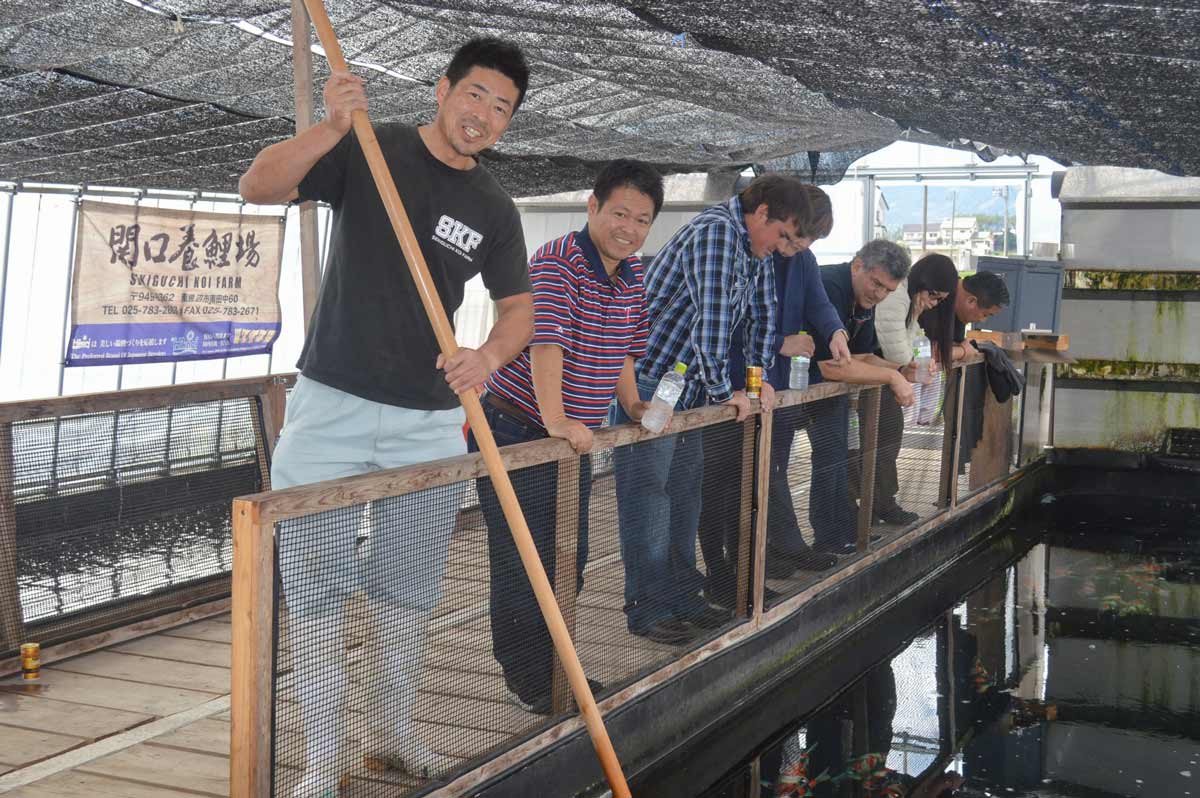
We came here, too, last year; and I need to tell you that this guy really knows how to breed great Showa. Dainichi and Isa have nothing on him.
The Showa here are spectacular such that I bought a nisai last year and kept in here for the past year, but not in the outdoor mud ponds. Mr. Sekiguchi kept mine inside “in concrete,” as it is described i.e. not in mud, but concrete, get it? Last year Mr. Sekiguchi also showed us a nisai that he claimed was tategoi—a koi with tremendous potential to become great. Only at the time, she was pretty bland appearing with very little developed sumi. He wanted me to buy her too, to “take the gamble,” he said. I declined.
So now Mr. Sekiguchi brought us into the greenhouse containing my Showa, now sansai. She had developed very nicely and kept beautiful features. The only minor issue I had was that she hadn’t grown as much as I’d have like, only adding about 3-4 inches from last year. Mr. Sekiguchi said that was because she was not put into the mud pond but rather kept in concrete. This turned out to be a good thing, and actually I should feel very lucky because the weather this past year was terrible for developing koi in the mud due to horribly hot and dry weather which made him cut back on appropriate feeding which in turn made the mud pond koi in large part quite disappointing.
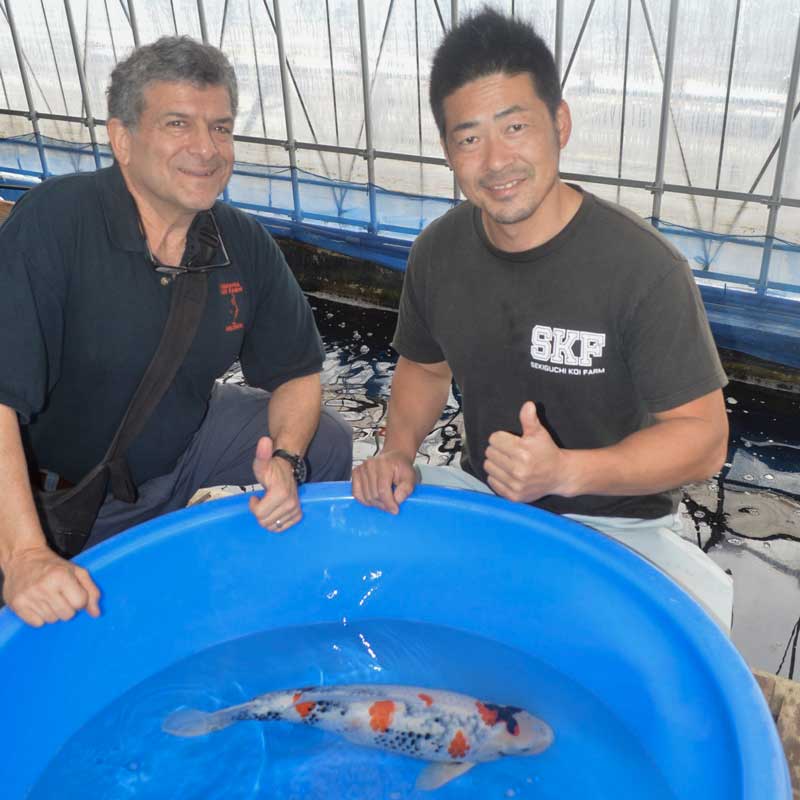
Interestingly enough the koi was much larger, way larger than mine kept in concrete, but the sumi had not changed in the slightest, this final result being due to theft she was out in the mud during the terrible summer. I immediately got an idea that maybe I could develop the sumi back in my pond with its rock-hard water. I made him a ridiculously low offer—way less than he wanted last year- and he accepted. So now I had purchased two Sekiguchi Showa, but remember I am liberated.
October 17, 2018
Hirashin Koi Farm. What in the world are we doing at this little-known, tiny farm? Well, as it turns out, I am looking for a Magoi! “Whaaaaht?! To eat?”, you ask. Of course not. You see, I, as a long-time koi nut, know where this crazy hobby came from; from whence it originated, as it were.
YES, from the Magoi, over 300 years ago when a Magoi developed a genetic variation, probably a bit of red or hi or beni as we now call it. Some old Japanese farmer decided not to eat it, but to put it in a pond and just watch it; and it’s a good thing he did this because he started our beloved koi hobby.
Having heard the Magoi brings luck to a pond, I decided I wanted one for my pond to honor it and be able to show visitors from whence it all began and had Taro get me a Magoi about 15 years ago. This wasn’t any easy feat as it turns out there was only one breeder who had them, a guy named Iketen, now defunct.
The Magoi that Taro got me turned out to be one of the finest koi in my pond in many ways. Over the course of 15 years in my pond, he (it was a male) got huge, over 35 inches and was simply beautiful, looking very black when he came up from the pond bottom and then seemingly getting brighter, more bronze colored as time passed.
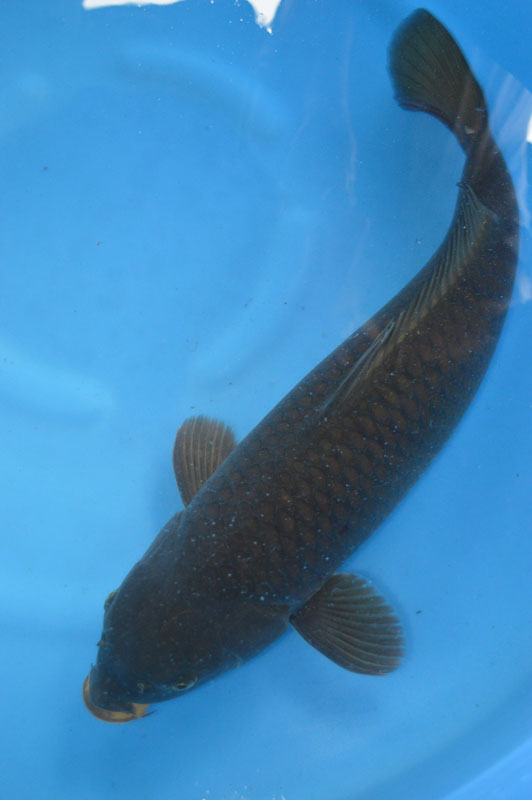
So now we are at Hirashin to buy Magoi. Mr. Hirashin is a bit taken aback because the demand for Magoi as pond fish is not great (at least not yet!)—for Japanese chefs, ah, maybe. Anyhow, when he sees we are serious about this desire for Magoi as pond fish, he shows us the only Magoi he has—6 sansai.
Taro asked him how come no nisai, and Mr. Hirashin said they are literally all “gone” to his close family members, who, by the way don’t even have ponds… We think about the implications of this and then…. don’t pursue it. I then convinced several of the members of our group to consider getting a Magoi for all the reasons I was. Well, I guess I was persuasive as we bought them all. I even swayed Taro who is considering getting Magoi tosai for his customers if this Magoi thing really gets off the ground.
I eventually buy a nisai Shiro Utsuri which rivals Omosako and is about 2-3 grand less! I knew I could find one.
Other members of the group and Taro, too, take advantage of the great prices on very good Kujaku. This variety has always confused me—they all look good to me, even the ones that aren’t, so i pretty much stay away. Maybe I’ll study up with Taro’s father’s books and buy one next year… yeah, now there’s a great idea.
October 18, 2018
The first item on the agenda today is another Ikeage, but this time the mud pond harvest is with our secret breeder, Marukohei. We get to his place bright and early.
He is there waiting for us in his Japanese Dihatsu (I think is the manufacturer) Hi Jet harvesting truck which all the breeders have and which I have been telling Taro he should get for the farm in Hawaii to be really authentic, official, and just plain cool. Taro says he’d love to, but getting parts for it would be a problem. Always the practical one, but that’s why he is the farm president, and I am not.
Kohei hops in the Hi Jet, and we following him was up into the mountains to his secret mud pond which is literally above the clouds. I know this because we are looking down at them. The pond has been subtotal emptied to a depth of about 3 feet. The water in these ponds in characteristically green and cloudy, and we can’t seen any of the 40 koi including my two from last year, Kohei assures us are in here.
Another car drives up from below us, and it turns out to be Kohei’s friend and helper, Mr. Matsuda which makes a total of 2 guys to harvest a huge pond and 40 koi. From the harvests I have witnessed, it takes many more than this as it is hard and strenuous work. After another 10 minutes during which no more helpers show up, Kohei, holding a pair of bright purple waders, turns to me and asks if I want to be the 3rd guy and actually participate in the harvest.
I am awestruck at first because this is numero uno on my “bucket list” i.e. to really BE in a koi harvest—not just observing–but actually doing it!!
I am ecstatic, no make that supra-ecstatic, because not only am I participating in a harvest, but I will be harvesting MY OWN KOI! I know that this is literally a once in a lifetime event as I put on the waders (purple is a natural for me in waders by the way). I know I am a damn “chick magnet” as I walk out into the mud pond. My ego is dampened a little when Kohei yells at me to get off the net I’m standing on as they drag it around the periphery of the pond.
With my ego now in its correct place, I take my place on one side of the large seine net and slowly pull it in, still unable to see any koi. However, this soon changes as the net is gathered and then staked out to an area of about 6 by 10 feet.
All of a sudden, there are swarms of koi breaking the shallow surface.
Mr. Matsuda, cigarette in mouth, of course, begins hand-loading koi one by one into large plastic bags and in turn then has to haul each one up a steep, muddy slope up to the truck where Kohei waits to put them into the tanks on the truck’s bed.
This will take all day at this rate, so he asks if I can start to do the hauling up the slope. I am more than willing and end up carrying 20 or 30 up to Kohei waiting at the top. I figure out that by this time we have to be close to getting them all and I haven’t seen my two yet—this could be a bad thing as koi do get lost for various reasons in the mud ponds.
However, as I look into the muddy water—hallelujah—there were both of my koi and looking great to boot! Mr. Matsuda picked up one of my Sanke, put it in the little inflatable kiddy pool (they really must get a more sophisticated implement for this than a blow-up kiddy pool) and I, myself, slid her into the bag and brought her up to the truck, just like you see on the TV!
My other koi looked just as great once she came out, both having put on great girth and length since I last saw them. I ended up buying a 3rd Sanke as well—like I said, these are the finest Sanke I have ever seen including the big boys, Marudo and Sakai.
After this unique and wonderful experience, Taro takes us back to Koshiji because he claims when we were here before, we missed Mr. Kase’s best koi, his Gosanke. Taro is correct, of course, as the Showa here are very good, approaching Sekiguchi’s and even Isa’s in quality. I end up buying a wonderful nisai for a great price, realizing I am in great denial concerning where in the hell I am going to put all the koi I am buying. Oh well, I am here to buy koi and buy I will; and let God sort them out once I get home. Holy cow, liberated or not, my wife is going to hang me out to dry when she sees my list!
We stop for lunch at a little mom-and-pop place off the highway where it’s not uncommon to see one of the breeders eating lunch. We walk in; and lo and behold, there is the owner of Nogami Koi Farm along with his son. Contrary to popular belief, his name is NOT Mr. Nogami, but Mr. Hisato, his first name being Nogami. Be that as it may, it is so great to travel around this area and run into the breeders just living their normal lives eating, shopping or just driving around. I forget that they ARE just normal and usually humble people and not the movie star types they seem like to me from having seen so much about them in videos, magazines, and various koi textbooks.
Oya Koi Farm is our next destination today. They are famous for Asagi and Sanke. Since I am “Sanked-out” from buying 3 award-winning Sanke from Marukohei, I concentrate on the Asagi I see here and buy a very nice 22-inch nisai with preface scalation and beautiful blue color that has a great square face, meaning to me it is going to get very big.
After Oya, we go again, probably for the 4th or 5th time, to Hiroi Koi Farm which is home to great specimens of many unusual varieties. I see and immediately fall in love with a Doitsu Ochiba—nisai and 24 inches long already. I buy it and am shortly proud of myself for then saying “NO!” to an equally beautiful Kikusui that somebody else had bowled, but didn’t buy. (In retrospect I probably should have taken it too—it was that good).
October 19, 2018
I’m a bit melancholy as this is my last day to hunt for koi on this trip; and believe it or not, we haven’t yet been to Marudo in earnest. I say “in earnest” because we have stopped here; but just went into the houses where his non-Gosanke are kept, i.e. Chagoi, Karashigoi, Mukashi Ogon, etc. I am not by any means downplaying these varieties as Marudo has some of the finest examples of these that can be found. It is just that Marudo is also a breeder of some of the best Gosanke in the world—his Kohaku have won the Grand Champion in the Nyogosai for the past 2 years. His Sanke are even more famous and go for very high prices.
We proceed into the greenhouse where recently harvested nisai are to be found and the first koi that stands out to me is, believe it or not, a simple astounding Aka Bekko! This variety is little known and therefore, very hard to find, especially a good one. I ask Mr. Hirasawa—no his name is NOT Mr. Marudo!—what’s with the Aka Bekko? He tells me through Taro that every year he gets a couple of Aka Bekko from his Sanke breeding, and they are good enough to keep and sell to weirdos like me. (No, he didn’t actually say the “weirdos like me” thing, but he was likely thinking it!) Anyway, I like unusual koi; and this Aka Bekko fits the bill with brilliant beni and well-placed sumi.
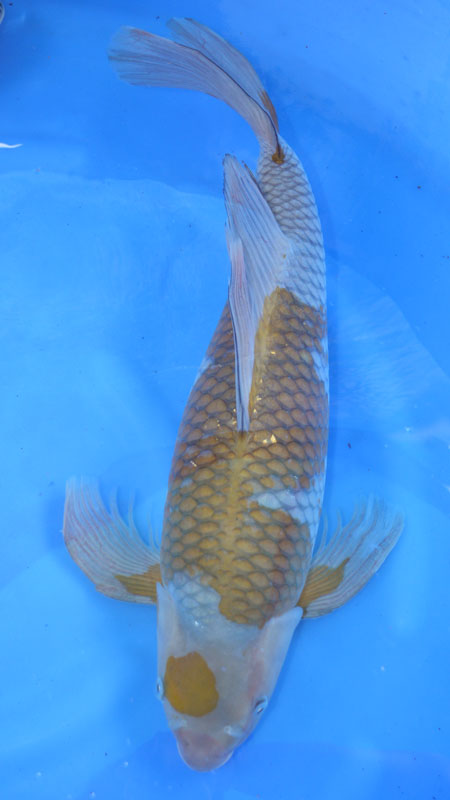
Whew! I’m safe as I am not a big fan of Butterfly koi, although I did have a huge female Ginrin Butterfly Kohaku, named Monarch, I bought second-hand from a guy about 15 years ago that lived until over the age of 25 years and maybe, just maybe I should look for something to replace her.
I mean how often does one get to Suda? And besides maybe he won’t be producing Butterfly much longer because like last year he didn’t produce any and that’s why this year there are no nisai. So if I don’t buy one this year and then come back next year; and there are none to be had well, then……. yeah, I bought a gorgeous Ochibashigure Butterfly that would be great even if it wasn’t a Butterfly. I justified it to my wife by telling her it is a gift for her.
Nope, I’ve used that one before; and she’s wise to it.
Well, that was not close enough. I took the wrong train North to the City of Niigata luckily realizing it before irreparable damage was done. Like Peter Waddington said in his book, “If your Shikansen train is not precisely on time, your watch is off.”
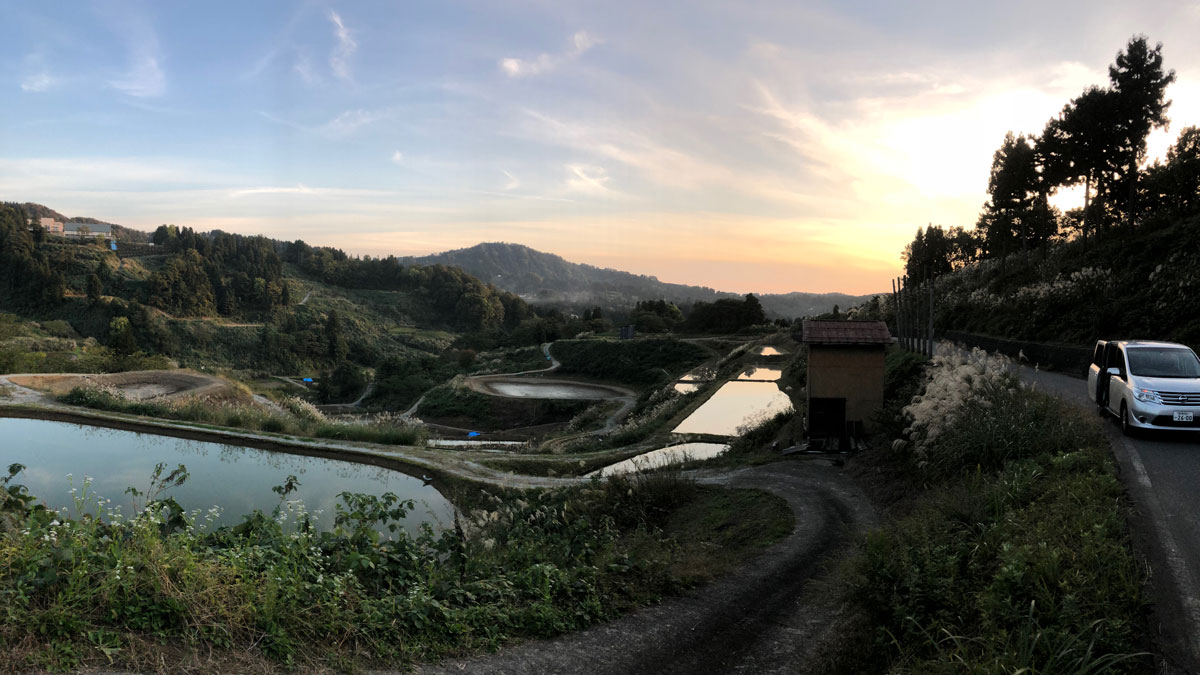
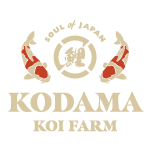
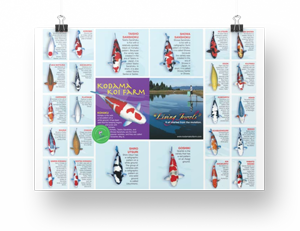

God is that Tonysan HANDSOME!!
Tony-san, yes you ARE!!!!, especially in the purple pants
One of the best articles I’ve read in a very long time. You can feel the excitement and passion of Dr. Malone and can empathize how he rationalizes the number of koi he ultimately purchases. I think every hobbyist going to Japan would want to buy every koi that they saw. Definitely makes me want to go to Japan sooner than later!
Thank you for the feedback. I love this article too
I loved this article! Anthony’s style of storytelling was superb. After having been to Japan a couple years ago with Taro it brought back many wonderful memories. I was also lucky to meet Anthony years ago at the koi show in Oahu. He was really friendly and gracious in sharing his knowledge about koi. I would love to see his beautiful koi collection. Thanks for sharing all your wonderful experiences.